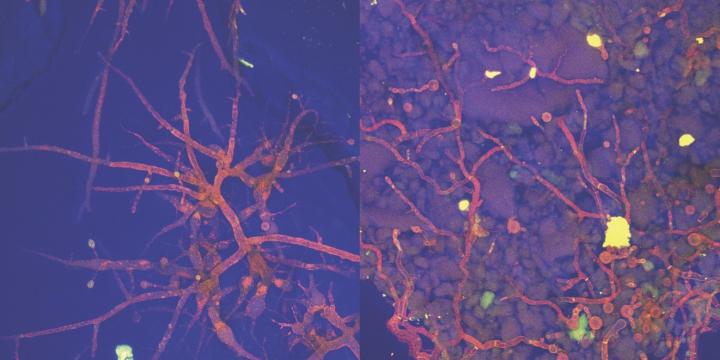Transparent soil substitutes can be used to study the interactions of bacteria and fungi in the soil, which may enable scientists to learn more about how soil microbes contribute to a healthy ecosystem

Credit: Sharma et al. (CC BY 4.0)
By using two different transparent soil substitutes, scientists have shown that soil bacteria rely on fungi to help them survive dry periods, says a study published today ineLife.
The findings indicate that these soil-like substrates may enable researchers to observe the complex interactions of the myriad microscopic creatures that live in soil. This ability is crucial to help us better understand the role that soil and soil microbes play in healthy ecosystems.
Millions of microscopic organisms such as fungi and bacteria live in the soil. They are essential for healthy ecosystems because they support the growth of plants and capture and store carbon from the atmosphere. But studying these processes in real soil can be challenging.
“To advance the study of soil processes, we used transparent soil substitutes that allowed us to use microscopes and other experimental techniques to see and measure the activity of soil bacteria and determine how this activity depends on the fungi,” says lead author Kriti Sharma, who completed the study as a doctoral student at the University of North Carolina at Chapel Hill, US, and is now a postdoctoral scholar at Caltech, Pasadena, US.
In the experiments, Sharma and collaborators from Vienna, Austria, successfully grew soil bacteria and fungi in two transparent soil substitutes. One was a synthetic substance called Nafion and the other was a naturally occurring crystal called cryolite. They also demonstrated that it was possible to observe living microbes in these substitutes using a microscope and to measure the organisms’ overall metabolic activity and uptake of carbon using a technique called Raman microspectroscopy.
Next, they used the soil substitutes to study what happens to bacteria when soil goes from being dried out to wet again. The experiments showed that while many soil bacteria die or become inactive when soil dries out, bacteria living near dead fungi remain active and use the fungi as a source for carbon. “In this way, fungi promote the activity of soil bacteria in changing environmental conditions,” Sharma says.
The transparent soil systems reported in the study will likely be used by many other researchers who study soil ecology, adds senior author Elizabeth Shank, Associate Professor in the Program in Systems Biology and Department of Microbiology and Physiological Systems at the University of Massachusetts Medical School, Worcester, Massachusetts, US.
“For example, they could be used to explore how interactions between bacteria, fungi, and other microscopic creatures living in soil help support the growth of crops,” she says. “Or to better understand how carbon is stored and released from soil, which may be critical to combating climate change. Overall, these transparent soil substitutes are powerful tools that will help us answer many outstanding questions in soil microbial ecology.”
###
Reference
The paper ‘Transparent soil microcosms for live-cell imaging and non-destructive stable isotope probing of soil ecosystems’ can be freely accessed online at https:/
Media contacts
Emily Packer
Media Relations Manager
eLife
[email protected]
+44 1223 855373
Jim Fessenden
Media Relations
UMass Medical School
[email protected]
+1 508-579-2934 (cell)
+1 508-856-2688 (office)
About eLife
eLife is a non-profit organisation created by funders and led by researchers. Our mission is to accelerate discovery by operating a platform for research communication that encourages and recognises the most responsible behaviours. We work across three major areas: publishing, technology and research culture. We aim to publish work of the highest standards and importance in all areas of biology and medicine, including Ecology and Microbiology and Infectious Disease, while exploring creative new ways to improve how research is assessed and published. We also invest in open-source technology innovation to modernise the infrastructure for science publishing and improve online tools for sharing, using and interacting with new results. eLife receives financial support and strategic guidance from the Howard Hughes Medical Institute, the Knut and Alice Wallenberg Foundation, the Max Planck Society and Wellcome. Learn more at https:/
To read the latest Ecology research published in eLife, visit https:/
And for the latest in Microbiology and Infectious Disease, see https:/
About the University of Massachusetts Medical School
The University of Massachusetts Medical School (UMMS), one of five campuses of the University system, is comprised of the School of Medicine, the Graduate School of Biomedical Sciences, the Graduate School of Nursing, a thriving research enterprise and an innovative public service initiative, Commonwealth Medicine. Its mission is to advance the health of the people of the Commonwealth through pioneering education, research, public service and health care delivery with its clinical partner, UMass Memorial Health Care. In doing so, it has built a reputation as a world-class research institution and as a leader in primary care education. The Medical School attracts more than $266 million annually in research funding, placing it among the top 50 medical schools in the nation. In 2006, UMMS’s Craig C. Mello, PhD, Howard Hughes Medical Institute Investigator and the Blais University Chair in Molecular Medicine, was awarded the Nobel Prize in Physiology or Medicine, along with colleague Andrew Z. Fire, PhD, of Stanford University, for their discoveries related to RNA interference (RNAi). The 2013 opening of the Albert Sherman Center ushered in a new era of biomedical research and education on campus. Designed to maximise collaboration across fields, the Sherman Center is home to scientists pursuing novel research in emerging scientific fields with the goal of translating new discoveries into innovative therapies for human diseases.
Media Contact
Emily Packer
[email protected]
Original Source
https:/
Related Journal Article
http://dx.




